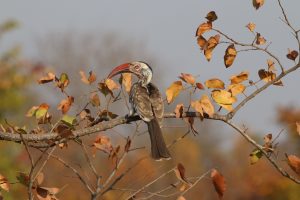Zambezi National Park Private Wildlife Safari

Short description: Explore the diverse wildlife of Zambezi National Park with an expert private safari guide. Get up close and personal with more than 400 species of birds and mammals such as elephants, lions, leopards, various antelope species, zebras, buffalos, giraffes, warthogs and many more.
Activity Highlights:
- Enjoy the privacy of your own car and see more than on group tours.
- Explore different habitats to see a maximum number of species such as the shore of the mighty Zambezi River, shrubland and savannah.
- Get up close with easily seen mammals in the park such as Elephant, Chacma Baboon, Mongoose, Zebra, Impala, Wildebeest, Waterbuck, Buffalo, Eland, Kudu, Giraffe, Warthog and Hippo.
- Profit from your guide’s experience to find more elusive mammals such as Jackal, African Wild Dog, Serval, Lion, Leopard, Hyena and Sable Antelope.
- Learn about much more than mammals from your guide who has expert knowledge on over 400 birds found in the park as well as a good knowledge of plants.
Included: Expert safari guide, Hotel pickup and drop-off, 4×4 vehicle, Water, Food (Picnic or Snack) included for 7-hour and 10-hour tour
Excluded: National Park entrance fee (international guests 15 USD, Zimbabweans 5 USD), Gratuities
Duration & Price:
4-hour private safari: 290 USD (per person)
7-hour private safari: 310 USD (per person)
10-hour private safari: 370 USD (per person)
If you are more than 3 people, we can give you a discount on the above prices. Please contact us directly to get a more specific quote tailored to your requirements.
Full description:
Explore the vast, unfenced and genuine wilderness of Zambezi National Park. This private safari can be booked as 4-hour, 7-hour and 10-hour tour. If you are a nature enthusiast, we highly recommend you book at least 7 hours. A full-day tour (10 hours) will offer the best experience. Finding various animals needs time and patience. The Zambezi National Park can be reached within only a five-minute drive from Victoria Falls town, so there are no lengthy transfers involved.
On this private safari, you will have your own car which means you have an excellent chance to find the specific animals you are looking for. Learn from your guide who has expert knowledge on mammals, birds and plants as well as nature conservation issues.
The vast Zambezi National Park covers an area of 56’000 hectares and features diverse habitats such as the mighty Zambezi River, shrubland and savannah. With over 400 species of birds recorded the park is a true birder’s paradise. For mammals, the park is home to four of the Big Five: You will have the highest chances to see elephants and buffalos whereas lions and leopards are more difficult to see. Other easily seen mammals in the park are Chacma Baboon, Mongoose, Zebra, Impala, Wildebeest, Waterbuck, Buffalo, Eland, Kudu, Giraffe, Warthog and Hippo. Your expert wildlife guide will help you to find rare or elusive species such as Jackal, African Wild Dog, Serval, Hyena and Sable Antelope.
A highlight of the park is the game drive route along the mighty Zambezi River. The Zambezi River forms the northern border of the park, and it also acts as the border to Zambia for much of its length. In the dry season, the river shore attracts a lot of animals and you will also be able to see typical river species such as hippos and crocodiles as well as many birds. The sprawling waterways of the Zambezi River are inhabited by over 75 species of fish with the most interesting species being the Tiger fish. The road along the Zambezi River has 25 numbered sites that are ideal for taking a break, stretching your legs and admiring the unspoilt natural beauty of the mighty river.
Please note that during the rainy season (November to March) it is generally more difficult to see mammals as they tend to spread all over the park. Also, the conditions of the roads will be worse in the rainy season. In the dry season (August-October) mammals tend to congregate around the river making it easier to see them. However, the rainy season is better for birdwatching as the local resident species are joined by a vast array of Palearctic and intra-African migrants. It is also the nesting season for the resident birds and a great time to see them in their colourful breeding plumage.











